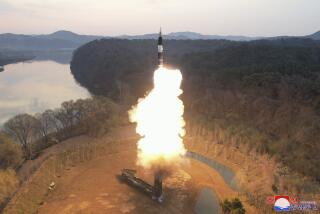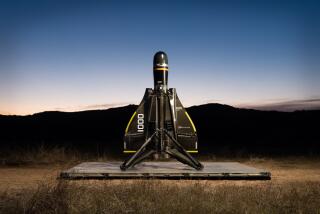Kill Vehicle Scores a Hit With Proponents of Missile Defense
A Minuteman missile carrying a dummy nuclear warhead soared across Southern California’s crystal-clear sky this month on the way to its destruction over the Pacific Ocean, part of a high-stakes test of the Bush administration’s ballistic missile defense plan.
The missile was pulverized in space by a compact device, dubbed the exoatmospheric kill vehicle by engineers and described as the most sophisticated weapon ever developed.
The test marked the third consecutive time that the device, the product of research labs around Southern California, scored a bull’s-eye in space. The kill vehicle is at the heart of the missile defense system.
For more than 20 years, missile defense proposals have failed to gain credibility, but the current system and the success of the latest intercept have emboldened Pentagon officials. They called the March 15 test a major step in the program, though many thorny problems remain and the future of the program is hardly assured.
The kill vehicle has the job of intercepting a warhead at a closing speed of 15,000 mph--more than four miles a second or five times the speed of a bullet. It must measure where it is going, calculate a collision path and operate rocket thrusters to score a hit in millionths of a second at the very end of its flight. The kill vehicle not only has to find its target in the void of space, but distinguish it from decoys and other countermeasures.
“It’s like hitting a golf ball across the country, from Los Angeles to New York, and getting a hole in one even though the pin is moving and there are whole bunch of others that look just like it,” said Charles F. LaDue, Raytheon Co.’s program manager for the weapon, also known as the EKV. “And we’re going to have to do that every single time. The consequence of failure is tremendous.”
The vehicle was developed by Raytheon’s unit in Southern California and assembled at its missile plant in Tucson. Key pieces of the device--along with much of the entire missile defense system--were designed or developed here.
The device carries a range of sophisticated items, including optics to navigate by the stars, antennas to receive data from ground radar, a small computer and a refrigeration unit to form krypton ice cubes for cooling sensors. The whole thing can fit on a kitchen table.
Because it carries no explosives or other munitions, the kill vehicle destroys the target by the sheer force of the collision. But hitting the cone-shaped warhead, typically about 6 feet tall, isn’t enough. The device must hit the warhead at its so-called sweet spot--measured in centimeters--where the nuclear munition is housed to prevent an errant nuclear explosion.
“There is nothing that the Department of Defense has done that is as difficult,” said Philip E. Coyle, a former assistant secretary of defense, who is senior advisor at the Center for Defense Information.
As such it also has been the most controversial. Despite four successful hits out of six tries--including the March 15 test that included distinguishing the warhead from three Mylar balloon decoys--critics have questioned the capabilities of the kill vehicle’s sensors to adequately distinguish a warhead from decoys.
Just adding more decoys does not increase the difficulty of the test, said David Wright, a senior staff scientist at the Union of Concerned Scientists, a group critical of the program.
They also raise doubts about other countermeasures that an enemy might put up. The critics say an enemy could refrigerate a warhead to confuse the kill vehicle’s sensors, an argument that defense experts dismiss as technologically unfeasible.
Moreover, Wright said, the whole missile defense system requires detailed knowledge of how warheads would appear to the kill vehicle’s sensor, an intelligence task that is “highly unrealistic.”
Officials at the Pentagon and at Raytheon acknowledged some of the criticism, noting that the initial tests were not meant to be realistic but to prove the technology and gather data to field an operational device, sometime in 2005.
For instance, interceptor tests, planned about every four months, are expected to increase in complexity with more decoys and other countermeasures. And within 18 to 24 months, Raytheon officials plan to test the kill vehicle without any advance knowledge of what the targets may be.
“It’s a flight test program,” LaDue said. “You want it well-instrumented and measured. It’s what you want to do in a test program.”
After logging a hit in its first attempt in October 1999, the second test was botched by a glitch with the kill vehicle’s cooling system and in the third test the device failed to separate from its booster. The device has since had three consecutive hits.
The Pentagon plans to conduct 20 more tests to help develop a final design for the kill vehicle.
Despite what seems to be a very difficult task, hitting a warhead is not as challenging as developing the technology to discriminate targets, missile defense officials said.
In 1982, the Army tested a “hit-to-kill” device that after three failures hit a target missile. The program was canceled after it was determined that the tests had been rigged. In any case, the device was considered too heavy and expensive.
Since then, vast improvements have been made with both the sensors and the computer processing power.
The target missile is a modified Minuteman II with a dummy nuclear warhead and decoys, launched from Vandenberg Air Force Base. A military satellite orbiting Earth detects the target and relays the information to ground radars in Hawaii and on Kwajalein Island, about 4,800 miles from California. The radars, also built by Raytheon, then begin tracking the target missile.
About 21 minutes later, a booster rocket carrying the kill vehicle is launched from Meck Island, near Kwajalein, headed toward the incoming missile.
The kill vehicle doesn’t much look like a weapon. And indeed, some have described it as resembling a large muffler or a jackhammer. It is just 55 inches long and weighs about 120 pounds.
Each device costs about $25 million, and Raytheon has a contract to build 26. It has built seven so far. Under current plans, the Pentagon sees buying up to 250--a potential production program of $6.25 billion--as it builds up the missile defense program.
As the booster makes its ascent, it uses a telescope with three mirrors and two infrared sensor systems to look out hundreds of miles for its targets, while getting help from ground radar. The telescope is made with beryllium to protect against electromagnetic pulse from potential nuclear blasts that could damage its electronic components.
Not long after launch, the kill vehicle starts its cryogenic refrigeration system, which cools the infrared sensors to hundreds of degrees below zero. Krypton gas is funneled to the area around the sensors. Krypton ice cubes form and stay with the device until it collides with the warhead. Cooling the sensors is vital to detecting and discriminating the target from decoys and countermeasures.
In Raytheon’s kill vehicle, the infrared sensors take precise measurements of heat radiation, distinguishing the relatively warm warheads against the ice-cold background of space. The readings are digitized, converted to a numerical value and analyzed by computers.
The infrared sensors, considered the most vital elements of the kill vehicle, were developed at Raytheon’s El Segundo facility. The sensors feed information into infrared detectors that analyze the signals. Those were developed by Raytheon engineers in Goleta, Calif.
Exactly how it distinguishes a decoy from a real warhead is highly classified, but it uses computer algorithms to make the decision. The algorithm includes preprogrammed profiles of enemy warheads compiled by U.S. intelligence agencies.
About three minutes into its flight and 1,400 miles from the target, the device separates from the booster in a show of pyrotechnics as more than a dozen cables and connectors are blown off. The kill vehicle itself is gently pushed out by four springs.
Immediately after separating from the booster, the kill vehicle uses its thrusters to sharply move to its right or left to avoid getting hit from behind by the booster. It is carried forward to the target by only its own momentum. The four divert thrusters mounted on its sides were tested recently at Edwards Air Force Base, where the device was able to hover about 20 feet above the tarmac for about 30 seconds.
About 100 seconds before impact, the sensors are turned on and begin to detect and discriminate the target, sending signals to the computer that steers the device. Until this point, it navigates by using an inertial navigation system, aided by star sightings through a separate stellar navigation unit.
The computer uses Intel processors that are more than 10 years old--though Raytheon says it may upgrade to a newer chip. Most of the number crunching is completed by an electronics unit, Raytheon officials said.
Although small compared with other sophisticated satellites and weapons, the kill vehicle takes about 24 months to produce with about half of that time spent undergoing tests and sensor calibrations. There are no moving parts except for the valves on the thrusters. To ensure quality, Raytheon built a high-tech, dust-free manufacturing plant in Tucson.
“It’s a spacecraft that will have to stay in the ground for years and still be expected to work every time,” LaDue said. “It’s got to work every time. We just can’t miss.”
More to Read
Sign up for Essential California
The most important California stories and recommendations in your inbox every morning.
You may occasionally receive promotional content from the Los Angeles Times.










